Beautiful and bright flower bed will certainly become a central decoration of the site, so every owner tries to choose the most unusual and exotic plants and flowers. Very many types of flowering plants are pretty capricious and difficult to take root in our territories. An excellent option for creating a unique garden and a flower garden will be Rogers.
This is a thermo-loving plant, for us exotic, increasingly began to appear in our climatic zone. It makes it pleases with its beauty and ease of care, as a result of which for many years will become an integral part of your site.
In this article we will look at the features and description of the exotic flowering plant Rogers. We note the most popular types and varieties of Rogers, as well as tell about the main nuances of agrotechnology of cultivation.
Features and description Rogers
Rogeria is a perennial decorative plant, which belongs to the camneur family. It has its decorative decorativeness, since it is the leaves that are the main decoration of Rogers, which in the fall are painted in various shades, from purple to pinkish. To date, this plant is not very popular among the gardeners, however, the beauty of Rogers gradually attracts the attention of fans of flowering plants.
Rogers received its name in honor of Admiral John Rogers, who headed the expedition to China. From here from the mid-19th century, this exotic plant has spread all over the world.
Rhokesia description:
- The habitat of Rogers is considered China, Korea, Japan. Most often, this plant in nature grows along the shores of the streams, in glades and edges, as well as in wet forests and in the mountains. It is these nuances of Rhircia growth that needs to be taken into account when planting this plant on its site.
- Rogeria is a perennial grassy plant.
- It is a two-column flowering plant.
- Young plants are distinguished by a rod root system, more adults it becomes underground with a large number of processes.
- The height of Rogers may reach 1-1.5 m, while forming an empty bush with large leaves.
- The leaves of this plant are its main decoration. In diameter, up to 50 cm can grow, while the form can be cake or finish. They are very beautiful and embossed, bright green with a bronze tint. By autumn can change the color depending on the variety.
- Grow leaves from the most rhizomes on long stiffs. It is very often possible to meet the name "Roger Kashtanolistics", which very accurately conveys the similarity of its foliage with the leaves of chestnut.
- Rogersia has small flowers that are collected in inflorescences on a high bloomer, located among the leaves. In plants that grow in nature, white flowers. However, in derived garden species, flowers can be a pink, beige or cream shade.
- Flowering on average lasts about a month.
- Thanks to its exotic leaves, Rogers will become an excellent decoration of any garden. It perfectly harmonizes with other plants, creating a unique arrangement of landscape design.
- Rogersius is distinguished by its undemanding in care, so even an inexperienced gardener will be able to grow without problems.
Main types and varieties of Rogers
Rogersia is an eastern beauty, which is only gaining its popularity in Russia. In nature, there are about 9 types of Rogers, which differ in their appearance, especially the form of foliage. It is thanks to the diverse foliage of Rogers, you can easily distinguish all its main types and varieties. Among the 9 known species of this plant are the most common: the following are considered: cavity, beznoliste, Rogers Pilish, Rogers, Podophyll. Consider all these species.
Roger cavillation
This type of exotic roger is one of the most common in Europe and Russia. In height can reach from 80 to 180 cm, the blooms are also quite high - 120-140 cm. Its name This kind of Rogers learned for similarity with the leaves of horse chestnut. The leaves of the degree of conscise polyoliste grow from the roots on long cutters and have a seven-way form. A distinctive feature of this roger is an amazing color of the leaves. In case of breaking, they have a bronze shade, but over time the leaves become green. In size, leaves can reach 50 cm in diameter. Flowers usually possess white or light pink color, collected in small inflorescences. In nature is found in the mountains of China.
Roger conscise polyaliste has a small amount of varieties, most often it is used to eliminate hybrids.
Rhokers conscise trash:
- Rogersia Henry - High Grade Rogers with Pale Pink Flowers.
- Roger conquigatelatalized Henry - hybrid variety of this species. This variety of Rogers is characterized by its sun-resistance. In the spring of his foliage, there is a color of coffee with milk, and in the summer it becomes a bright green shade, which looks profitable in various garden compositions.
Rogers Piece
This is another view of Rogers, which can be found in our climatic zone. It grows not as high as degree of conscisionation. 70 cm reaches a height, but during active flowering can be pulled up to 120 cm. In nature, this plant grows in China, in the Yunnan area. This type of Rogers received its name due to the form of its foliage - peristoidal. The diameter can reach 30 cm. During the start of the dissolution, all the foliage has a purple shade, which over time becomes dark green. Rhirusia is flowering in July snow-white or pale pink little flowers, which are collected in small inflorescences.
The main varieties of Rogers Celebration:
- Alba - This Rhircia variety is characterized by green foliage and snow-white flowers or with a yellowish tint.
- Elegance is the presence of pink flowers.
- Fireworks is one of the brightest varieties that is distinguished by colorful colors - cherry-red and pink. The foliage also pleases its diversity of shades - from bronze to bright green.
- Roger Chocolate Wings - This Grade Rogers stands on a mansion, stands out for its unusual appearance and ability to change the colors of foliage several times during the season. At the beginning of the vegetation, the leaves are painted in a chocolate tint, then gradually become multicolored with green and red splashes. In the fall, the whole flower is again painted in chocolate tones. Flowers at Rogers pink shade, which over time become reddish. Very popular variety among gardeners thanks to his bright appearance.
- Ideal - foliage of this variety has a dark green color with a small reddish rim along the edge. Flowers with red flowers.
Roger buzzinoliste
This kind of Rogers is extremely rare in the gardens and flower beds of Russia, since these flowers are more demanding of heat and do not carry cold weather. In height, only 70 cm can be achieved and, unlike other species, have a dissected form of foliage, which resembles a elderly. Flowerines grow 120 cm and beautifully tower over greenish-bronze foliage. Plant flowers with white or pink inflorescences.
Varieties of Buzinovaya Rogers:
- Red Skin - Plant with red-bronze leaves. White blooms with a gray-shade of inflorescences.
- Kupferschein - Sort of Rogers with Cream Flowers.
Roger stuffed or subophull
Sometimes this kind of Rogers is called Japanese. It grows very quickly and is particularly demanding to moisture. In height can reach 150 cm. Leaves with a glossy surface and a bronze tint. This type of degree cream-green inflorescences.
Still Rhokers:
- Big Mama is a rather large range of degrees with large in diameter with bronze tint leaves.
- Red Leaf - in accordance with the title, the foliage of this variety has a reddish chocolate color.
- Pagode - This variety has the longest flowering period. Inflorescences have a white shade.
Roger reproduction methods
Rogers of all kinds can breed vegetatively and seeds. Choosing one or another way, it is necessary to focus on the climatic conditions of your area. Only so you can get a beautiful blooming plant that will grow without problems in the open soil.
Reproduction of seeds
This method is extremely rare, since the seeds are pretty slow at home. And the blossom of young Rogers is beginning only for 4-5 years. However, if you decide to collect seeds yourself and grow Rogers just in this way, remember that these plants are easily self-esteem. And experienced gardeners are recommended to trust Rogers at some distance so that the varieties are not mixed.
- After collecting seeds in early spring, they must be stratified, i.e. Turn in natural conditions. To do this, it is necessary to prepare nutrient soil, moisten it. Then seeds are placed on the upper layer of the soil, the Earth is covered. Next, the container with seeds is placed in a cold room with a temperature of 0 degrees for 2-3 weeks.
- After stratification, the seeds are taken into more comfortable temperature conditions, approximately 10-15 degrees. At this temperature, the seeds begin to germinate.
- When all seedlings reach a height of 10 cm, they need to be signed in separate containers or cups.
- The seedlings are solarded and periodically water.
- When comfortable temperatures are installed on the street, the containers are set to open air.
- In the soil seedlings are planted in autumn.
Reproduction of Rogers dividing bush
This method is the most common and easy to use. By dividing a bush or rhizoma Rogers can be replaced for breeding or rejuvenation of the plant. It is best to do it in the spring or autumn period. The division of the bush is carried out in the spring, so that the plant will get growing to winter. And the division of the rhizomes need to be carried out in the fall, so that the parts of the root system can germinate.
- Rhizome must be divided into several small parts and put in containers with nutritional soil.
- Further containers are placed in the room with a temperature of 10-15 degrees for 4 months.
- Periodically, the soil must be moisturized.
- In the spring, germinated parts of Rogers root system are transplanted into open ground.
When dividing the bush, it is planted immediately into the open soil, in the pre-prepared soil.
Reproduction of Rogerschi Cherenca
Cuttings are also possible to grow this exotic plant. To do this, in the middle of the summer it is necessary to prepare cuttings - Leaves of Rogers with a heel. After that, the cuttings are placed in a special solution to accelerate the germination. Then the cuttings are plugged into the soil for rooting. This process is lasting before the appearance of strong roots, after which Rogersia is planted into open ground.
Preparation before landing Rogers to Outdoor Soil
To get a beautiful and decorative plant, must be carefully prepared. The preparation process includes the selection of high-quality Rhercia seedlings, as well as selection of space suitable for its growth and blossoms.
Seat selection
The choice of good seedlings is the key to getting a gorgeous flowering plant. Saplings can be purchased in specialized stores or nurseries. However, refrain from the purchase of landing material on various markets and from strangers. So you can get not quite high-quality material. When buying carefully inspect the seedling for damage and dried parts. The root system must be strong and healthy.
Seedlings can be obtained independently by rooting the cuttings. This is done in advance so that by the time of landing in the open ground, the plant managed to let the roots.
Selection of Places for landing Rogers
Be sure to pay attention to the landing site of Rogers. Open and solar place will not fit - the plant can perish. The location is perfect in lightweight, which is protected from sharp winds. Rogersia also feels very comfortable near the reservoirs and ponds, so you can easily and fall around the water. However, it is necessary to remember that the long-term location of the groundwater near the roots of this plant can destroy the root system.
When planting plants, consider that it quickly grows up, therefore, the places of Rogers need more.
Choice and preparation of the soil for landing Rogers
Rogersia prefers to grow on moisturized and light soils that are well reheated and fertilous. However, remember that it is not acceptable space with constant groundwater location, a plant may die from this. Therefore, when landing, it is necessary to provide a layer of drainage.
The process of landing Rogers to open ground
The optimal time for landing Rogers to open soil is the beginning of spring, so the plant will be able to strengthen the onset of cold.
Features of the landing of Rogers:
- Initially, it is necessary to prepare the ground for landing. To do this, on the selected area, turn the land to a depth of 30 cm and remove all weeds and turf.
- Next, you can easily eat the earth and saturate with its nutritional elements. Add humid, peat, deciduous and forest soil during soil processing. All thoroughly need to mix.
- After that, you need to dig the pits for planting seedlings. The size of the pit should be a little more root system.
- At the bottom of the landing well, be sure to place the drainage layer to prevent stagnation of groundwater. As a drainage, small pebbles, broken brick or gravel can be used.
- Next to the drainage, put a little prepared soil.
- Before boarding, be sure to break the container with a seedliness and carefully remove it.
- In the pit put a sapling of Rogers and slightly straighten the roots on the ground.
- Gently sprinkle the plant with soil and lose weight slightly.
- After landing, we swipe the landing circle and inspire it to hold moisture from the roots. As a mulch, you can use the bark of trees or peat.
Features of Rogers' care in the open soil
Like any other plant, Rogerscia requires care when landing in an open soil. However, in this process there is nothing complicated, even a novice inexperienced gardener will cope with all the stages. But in the future, Rogersia will thank you with chic appearance and bright flowering.
Watering Rogersius
Natural habitat Rohgria - wet forests and places in reservoirs. Therefore, at home, it is necessary to create the most approximate comfortable conditions for the growth of this plant. The flower loves moisture, and perfectly responds to regular watering. Especially abundantly watering Rogers is necessary during active growth and in the hot summer period. In a particularly dry time, you can please the plant with sprinkling.
Loosening and mulching
Periodically, the soil around the plant must be loosened and removed weeds. During loosening and weeding, the Earth is saturated with air, which is very important for the root system of Rogers. To prevent evaporation of excessive moisture from the soil, the priority circle can be meditated. The mulch is used bark or peat. Pour it possible periodically after loosening.
Up. Rogersiya
Rogers' care includes such a stage as feeding. Rohrusia reacts perfectly to the introduction of organic and mineral fertilizers. They are added throughout the plant growth time. It is especially important to feed Rogers during active growth and flowering. At this time, you need to make the organic and complex fertilizers in which potassium, nitrogen, phosphorus, zinc, copper and magnesium should include. Putting fertilizers can be combined with watering.
Fighting pests and diseases
Rogerscia has unique antiseptic properties, which contributes to the protection of plants from various pests and diseases. However, sometimes you can find damage to the root system with slugs and leaves by rot. In such cases, it is necessary to remove damaged areas and process the plant by fungicide, preferably during the daytime. But the main thing is to remember that it is easiest to prevent the disease. And for this you need to observe the regime of irrigation and not to fill the roger.
Preparing the Plant for Winter
In the fall, it is necessary to break all the dried shoots and leaves, also gently cut the flowers. Next, you can make fertilizers and cover the ground part of the plant with foliage or peat. Roger is considered a frost-resistant plant, however, in case of return freezers or a slight snowy winter, it is worth covering the plant with spunbond.
Using Rogers in Landscape Design
Rogersia is a very unique and bright plant. It is a decorative and decorative flower plant, so it is perfect for creating various garden compositions. It will perfectly look at the design of flower beds, as well as to create compositions with deciduous and coniferous trees.
Rogersia can be used to framing paths and creating borders. The main feature of the plant is the possibility of planting along the water bodies and in the shade, which allows you to create a unique landscape design.
Stock Foto Rogers in landscape design
All features of this exotic flowering plant in landscape design can be seen in the following photos.
Roger in a separate landing
Roger among deciduous plants
Roger along Garden Road
Beautiful and well-kept plot is the dream of every gardener. Therefore, all lovers and professionals seek to find some unique and special plants that can distinguish their plot. Rogeria is an excellent option for gardening a garden that does not require special efforts to grow. But in the future it will decorate the garden or flower garden with a bright appearance.

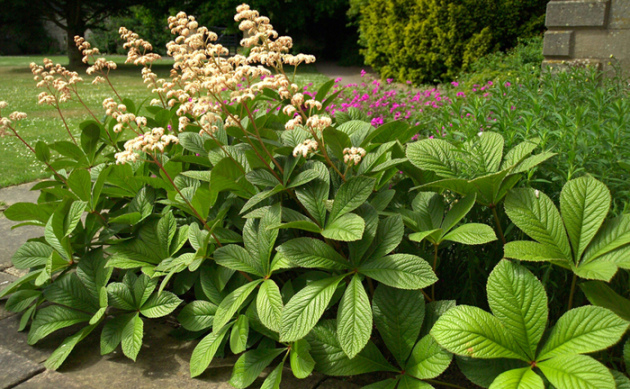
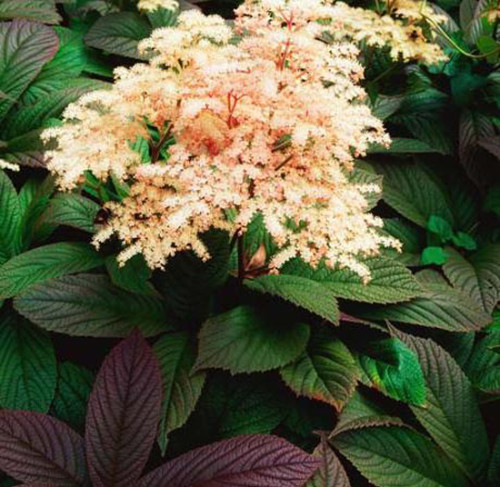
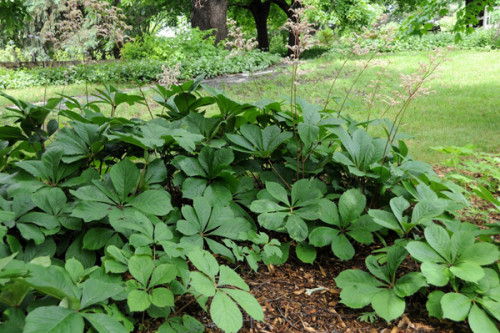

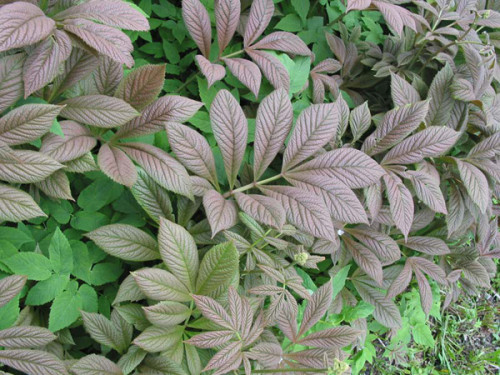
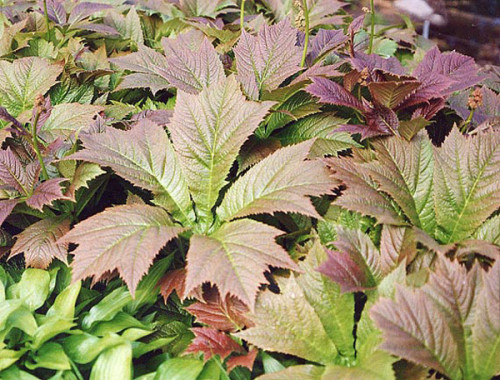

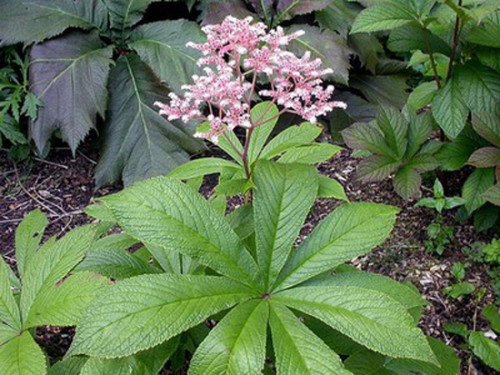
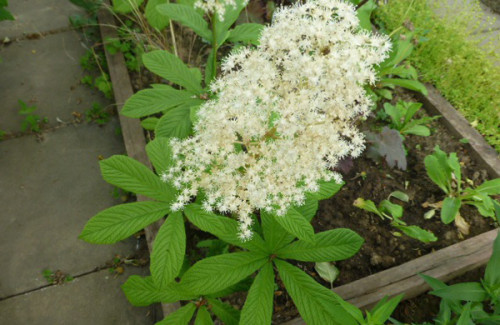
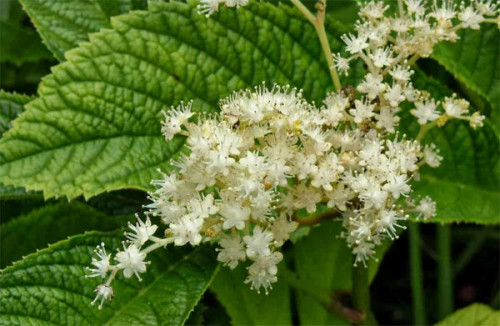
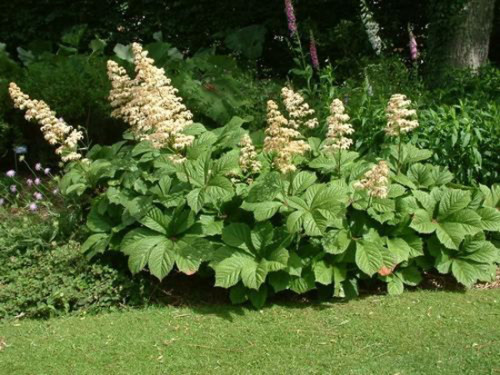
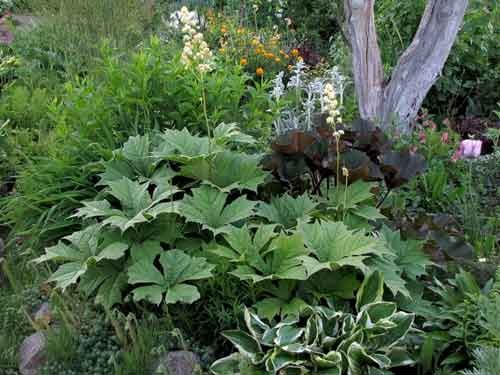
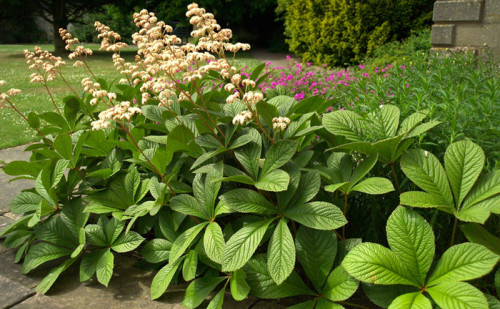












 Start a discussion ...
Start a discussion ...